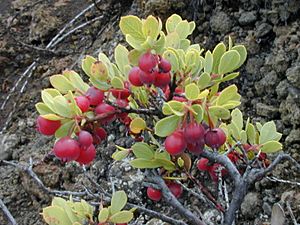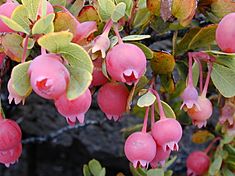Oheloberries facts for kids
Quick facts for kids Oheloberries |
|
|---|---|
 |
|
| Scientific classification | |
| Kingdom: | |
| (unranked): | |
| (unranked): | |
| (unranked): | |
| Order: | |
| Family: | |
| Genus: | |
| Species: |
V. reticulatum
|
| Binomial name | |
| Vaccinium reticulatum Sm.
|
|
| Synonyms | |
|
|

Vaccinium reticulatum fruits, Maui
|
|
| Nutritional value per 100 g (3.5 oz) | |
|---|---|
| Energy | 117 kJ (28 kcal) |
|
6.84 g
|
|
|
0.22 g
|
|
|
Protein
|
0.38 g
|
| Vitamins | Quantity
%DV†
|
| Vitamin A equiv. |
5%
42 μg |
| Thiamine (B1) |
1%
0.017 mg |
| Riboflavin (B2) |
3%
0.036 mg |
| Niacin (B3) |
2%
0.27 mg |
| Vitamin C |
7%
6 mg |
| Minerals | Quantity
%DV†
|
| Calcium |
1%
7 mg |
| Iron |
1%
0.09 mg |
| Magnesium |
2%
6 mg |
| Phosphorus |
1%
10 mg |
| Potassium |
1%
38 mg |
|
Link to USDA Database entry
|
|
| †Percentages estimated using US recommendations for adults. | |
Vaccinium reticulatum, also called ʻōhelo ʻai in Hawaiian, is a type of flowering plant. It belongs to the heather family. This plant is special because it grows only in Hawaii.
You can find ʻōhelo ʻai growing on lava flows and fresh volcanic ash. It likes places that have been recently changed by volcanoes. It grows at high places, from about 2,100 to 12,100 feet (640 to 3,700 meters) above sea level. It is most common on Maui and Hawaiʻi island. You can also find it, though less often, on Kauaʻi, Oʻahu, and Molokaʻi. This plant is very tough. It can even survive when more than 10 inches (25 cm) of volcanic ash falls on it!
What ʻŌhelo ʻai Looks Like
ʻŌhelo ʻai is usually a shrub (a small bush) that is about 4 inches to 4 feet (0.1 to 1.3 meters) tall. Sometimes, it can grow taller, up to 6.5 feet (2 meters).
Its leaves stay green all year round. They grow in a spiral pattern around the stem. The leaves are tough and feel like leather. They are oval-shaped and about 0.4 to 1.2 inches (1 to 3 cm) long. When new leaves first appear, they are red. Later, they turn green or green with some reddish spots.
The flowers of the ʻōhelo ʻai plant look like bells. They are about 0.3 to 0.5 inches (8 to 12 mm) long. Their color can be different, from red to yellow or pink.
The Fruit: ʻŌhelo Berries
The fruit of the ʻōhelo ʻai is an edible berry. This means you can eat it! The berries are about 0.3 to 0.5 inches (8 to 14 mm) wide. They come in many colors, like blue, purple, red, orange, or yellow. The color does not always tell you if the berry is ripe.
ʻŌhelo berries taste a bit like cranberries. If they are not fully ripe, they taste tart (a bit sour). Ripe berries are quite sweet, but their flavor is mild.
These berries are a very important food for the nēnē bird. The nēnē is a type of goose found only in Hawaii. When the nēnē eats the berries, it helps spread the plant's seeds. The seeds pass through the bird's body and are dropped in its waste. This is a natural way for plants to spread their seeds to new places.
See also
 In Spanish: Vaccinium reticulatum para niños
In Spanish: Vaccinium reticulatum para niños

